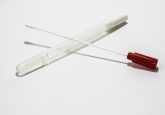Quantitative proteomics identifies biomarker for acute rickettsial spotted fever infections, say researchers

Researchers from the Department of Internal Medicine and Sealy Center for Molecular Medicine, University of Texas Medical Branch (UTMB, TX, USA) report the use of quantitative proteomics studies to discover a sensitive and specific biomarker that could enable the early diagnosis, treatment and public health notification of spotted fever rickettsial infections.
Rickettsiae are a collection of Gram-negative bacteria found in ticks, lice, mites, fleas and mammals that can cause severe infections in humans. Currently the assay used to diagnose rickettsial infections is limited by a lack of sensitivity, especially during the first week of infection, which can lead to misdiagnoses.
The research reported in the American Journal of Pathology, describes the use of a quantitative proteomics pipeline to identify a biomarker for rickettsial infection that could be used to aid the diagnosis of Mediterranean spotted fever (MSF). In a culture of primary human umbilical vein endothelial cells infected with the MSF-causing pathogen, Rickettsia conorii, researchers identified 46 upregulated proteins. Only one of these proteins was rickettsial in origin, the putative N-acetylmuramoyl-L-alanine amidase (RC0497).
After identifying the RC0497 protein using quantitative proteomics, the team began developing an assay to detect it. The RC0497 protein was successfully detected in the blood of a mouse model of R. conorii and serum samples from humans presenting with acute rickettsioses. Results from the study demonstrate that RC0497 levels are significantly different between infected individuals and healthy controls. Furthermore, circulating levels of RC0497 appear to correlate with the severity of infection.
If future research leads to validation of the RC0497 biomarker with a larger cohort, the biomarker could facilitate the early detection and treatment of rickettsial infections via a portable point-of-care diagnostic test. Co-author, David Walker (UTMB Center for Biodefense and Emerging Infectious Disease) explained: “It is our long-term goal to convert this into a point-of-care diagnostic test that will revolutionize the diagnosis of spotted fever rickettsioses, making it available as therapeutic decisions are being made.”
Co-lead investigator Allan Brasier (UTMB) added: “This discovery opens the door for a deeper understanding of the spectrum and epidemiology of this re-emerging tick-borne disease. Importantly, the work is the product of an interdisciplinary team of infectious disease specialists, experts in tick-borne diseases, advanced proteomics/analytical chemists, and informaticists who collectively combined their skills to advance this field.”
Sources: Zhao Y, Fang R, Brasier A et al. Quantitative proteomics of the endothelial secretome identifies RC0497 as diagnostic of acute rickettsial spotted fever infections. Am. J. Pathol. doi:10.1016/j.ajpath.2019.10.007 (Epub ahead of print)(2019); www.eurekalert.org/pub_releases/2020-01/e-npd011420.php





